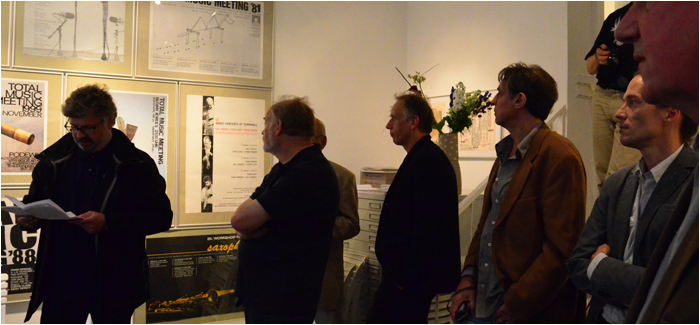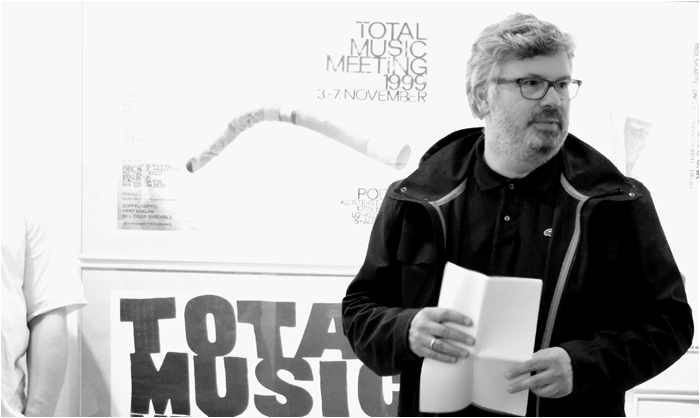| |

Markus Müller
44 Years FMP
Laudation on the occasion of the exhibition in Berlin Köpenick 2012
When it all began, in 1968, Jost Gebers and his long-term comrade-in-arms Peter Brötzmann had to learn just about everything that had to do with the music business, the organization of concerts and festivals, the recording of the music, the production and distribution of records. Later, in the times of Punk, this was called DIY, Do-it-yourself. And later still, the category of DIY aesthetics established itself. The Do-it-yourself aesthetic first and foremost focuses its attention on the design of the printed products, flyers, fanzines and record covers. While it was actually called as such in the Punk scene and, in the commercially successful formats as for example the cover of “Never Mind The Bollocks” by the Sex Pistols, it also looked like it, as if the band had glued together a blackmail letter on the kitchen table, in the case of the Pistols it was in fact already professionally designed by a third party - Jamie Reid is to answer for this iconic piece of design. FMP, however, actually did it themselves. Only Brötzmann wasn’t a DIY amateur. Brötzmann had worked together with Paik, Fluxus-Paik in Wuppertal, and he had a successful graphics agency which at least allowed him to first publish “Machine Gun” and “For Adolphe Sax” on his own label BRÖ.
In other words, what we see here, the FMP design, the graphics, the packaging, was the only area where one of the driving forces, Peter Brötzmann, actually had had professional training and the relevant experience to his name. Brötzmann was/is visual artist and graphic designer. And then Brötzmann, with his special kind of typography which has burned itself into our memory, in the best sense of the word, somewhere between hand type-set and potato printing, repeatedly helped to shape FMP over the years, his covers and his posters are just as much an essential part of the FMP image as is his music.
The first FMP printed product, however, the poster, the posters for the Total Music Meeting 1968, stem from Jost Gebers. Maybe he can tell us later on how he managed to do it, I am not actually aware of his having had of any kind of special training in this area?
Apart from Brötzmann, Kowald, Bennink, Christmann, Van Hove, Carl, Radu Malfatti, Reichel, Lovens, von Schlippenbach, Johansson and others have created the covers for their own productions. Brötzmann‘s Opus Magnum in this context is probably the box “For Example”, the documentation covering the first ten years of the “Workshop Freie Musik”.
Apart from Jost Gebers who, for example, did wonderful covers for Irène Schweizer, other designers were Dieter Hahne, the general heart and soul of the business, or Manfred Kussatz who, to my knowledge, did more design work for FMP - for example “Snapshot”, the documentation on Jazz from the GDR which came out in 1979 - than actual recordings, namely two, the wonderful “Working” (FMP 0750) and “Berlin Bones” (FMP 0930). Naturally also Nino Malfatti, Fritze G. Margull, or the mysterious Else Nothing and Graf Typo (“Der Traum der roten Palme” (FMP 0950), “Moon Mood” (FMP 0700)) and Wolf Walt who not only designed the Africa Djolé albums but also, for example, “Blek” (SAJ-32) have to be mentioned in this context. “Blek” shows the reproduction of a work by Nino Malfatti, an internationally successful visual artist, as is Günter Förg who is responsible for many of the Rüdiger Carl designs.
Also in the area of graphic design, the history of FMP is considerably more complex and varied than the stereotyped thinking of the eighties attempted to command. Kowald’s designs originate directly from his involvement and his acquaintance with international artists of the time the likes of, for example, Arakawa, Penck, Inoue, Basquiat or Tomas Schmit. Brötzmann creates a special kind of clarity which arrives at an entirely typical historical-artisan modernism of his own, somewhere between Bauhaus, Otl Aicher and Dieter Rams. “For Example” looks as if Apple and Instagram together had come up with a really good packaging for the next MacBook. It couldn’t be clearer, more classy or simpler. It is graphic design, intended for mass media production with its own personal signature. A crystal clear typography, as though printed through a Warhol-esque screen, with the courage to make evident the so-called ‘handmade’ production process, that’s Brötzmann. At the other end of the spectrum are to be found the graphic works of Hans Reichel who created his own design language in a very playful yet specific manner, explaining the functionality of his instruments in drawings and finally creating his own fonts which he successfully placed on the market.
The man who made all this possible over the many years was Jost Gebers. He was the motor, he was responsible for this “Wonder” through his painstakingly backbreaking work in the bureaucratic swamp of everyday life, as I described previously on the occasion of the 25th anniversary in 1994.
Fast forward: the first “Total Music Meeting” took place in 1968, the first “Workshop Freie Musik” in 1969, followed by the first LP of Manfred Schoof’s Orchestra, the “European Echoes” (FMP 0010) in 1969. Since that time, FMP has published, produced and presented innumerable kinds of music from all over the world. And alongside the many concerts and recordings, LPs, Singles and CDs, FMP has put out a total of five comprehensive documentations. “For Example” was released in 1978, the above mentioned documentation covering 10 years of Workshop, designed by Brötzmann. “For Example” contains 3 LPs and a 133-page book with numerous essays and countless photos. At that time, no comparable documentation of this kind had been published anywhere else. FMP set standards also regarding the documentation of its so very contemporaneous and improvisation based music. In 1980, “Snapshot” published music from the GDR on a double album, accompanied by a 48-page booklet. In 1989 “Cecil Taylor in Berlin” followed, 11 CDs and, again, a 188-page book as well as a discography of all musicians involved. This box has become the international standard for all future undertakings of this kind. Certainly it remains unequalled to the present day, and rightly most sought-after. All previously mentioned editions and several more (for example the great box Kowald-Duos and, naturally, the keystone, the FMP - In Retrospect) are on view in this exhibition.
To me, this insistent documenting and publishing of musical developments across all frontiers seems to be the essential contribution of FMP. There is no other area in the culture and art scene in the last 44 years where one can experience such fundamental and intrinsic developments as in the recordings of FMP.
In 1994, I wrote about these developments: Peter Brötzmann‘s path from the classic “energy orgy” “Machine Gun” to the often surprisingly melodic-lyrical recording of his quartet (Die Like A Dog), no less energetic but, in its essence, characterized by the ideal-typical way of playing together, would not have been imaginable without the decades of collaboration with FMP. Since “Pakistani Pomade” (1972, FMP 0110), the “Schlippenbach Trio” has developed into the most outstanding improvisation combo of our times. The recording “Elf Bagatellen” (FMP CD 27) from 1990 is a masterpiece of complex musical communication, in the musical as much as in the technical recording respect. And who would have guessed that “Messer” (Irène Schweizer, Rüdiger Carl, Louis Moholo, 1975, FMP 0290), Free Jazz at its finest, was recorded by musicians some of whom - almost 20 years later with the “Cowws Quintett” (Schweizer, Carl, Oliver, Wachsmann, Wittwer) - would present a production (Grooves ’n’ Loops, FMP CD 59) with edged, chamber-music like spacy dance-floor hits. If you listen carefully you can hear that Cecil Taylor‘s FMP recordings were a “milestone” not just for FMP. Obviously new perspectives opened up in Taylor’s playing, as well. Hans Reichel‘s “Wichlinghauser Blues” (1973, FMP 0150) was the foundation of a unique musical precise kind of beauty in Improvisation which, not without good reason, reminds many listeners of the Haiku. And Peter Kowald’s duo recordings (Duos Europa-America-Japan) are a programmatic example of the opening up of FMP and “its” music across all cultural and musical boundaries.
These developments have continued since 1994 but it would be going a bit too far to describe the past 19 years up to the present. In some cases these developments have been halted most tragically. Peter Kowald died in 2002, Hans Reichel last year.
Many of the others, however, carry on and also Peter Brötzmann carries on and as we have seen in Wels last year, Brötzmann is still and forever extending his and our imagination with regards finding fruitful and successful ways of making contemporary music.
A lot of what defines FMP can be seen and heard in this exhibition and on the wonderful website of Jost Gebers (http://www.fmp-label.de/index.php). One aspect which is essential for the image we have of FMP and this music today and which maybe is slightly underrepresented on the walls of this gallery, are the amazing photos, above all Dagmar Gebers‘ photos which have documented the concerts and events and can be seen on many of the recordings and in the above mentioned great documentations. I have already written about these photos in other contexts and also on Jost Gebers’ website in the preface to the Gallery, there are no other photos quite like them. They are a unique documentation and there are many reasons for this. The most plain and simple one was given to me by Dagmar Gebers last year on the occasion of the presentation of the German Jazz Prize to Peter Brötzmann. “Jost”, she said, “always used to set the lights specially for me, the light was always perfect for me and my photography.”
This is what Jost Gebers and FMP are about, what they always have been about, he knew what he wanted and he knew how to organize it for everyone involved, for the musicians, for the photographer and for us. This history of success remains to be written in my opinion, and the international recognition, the fact that records and recordings of FMP are reissued by others in the name of the musicians, shows that the interest in this history of success is continuously growing.
To the next 44 years.
Translation: Isabel Seeberg & Paul Lytton

Photos: Dagmar Gebers (2012)
back
|
|